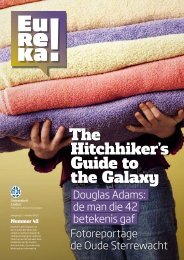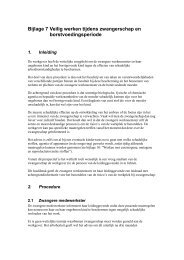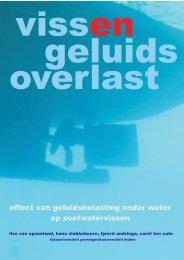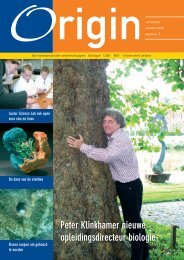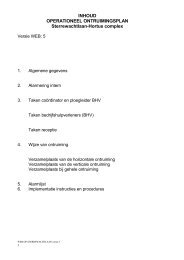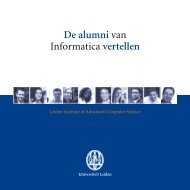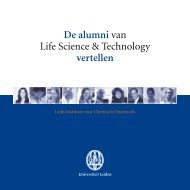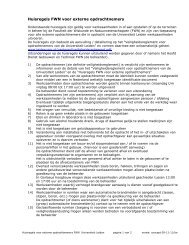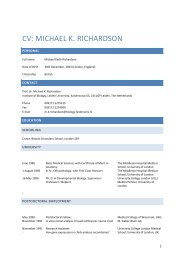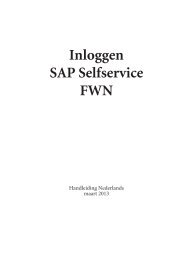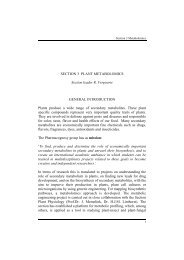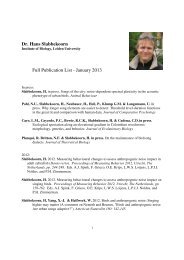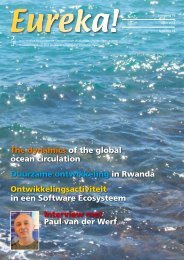WAAR WIJ TROTS OP ZIJN
WAAR WIJ TROTS OP ZIJN
WAAR WIJ TROTS OP ZIJN
You also want an ePaper? Increase the reach of your titles
YUMPU automatically turns print PDFs into web optimized ePapers that Google loves.
abundant bonding in chemistry<br />
by Martijn Verdoes<br />
Synthetic organic chemistry and biochemistry: two apparently<br />
completely different branches of chemistry. Yet they can come<br />
together in one researcher, which is the case with Martijn Verdoes<br />
whose PhD research manages to combine the best of both worlds.<br />
His project relates to selectively labeling particular proteins in order<br />
to make them visible and to isolate them. The molecules that he<br />
constructs are also useful as a tool for such purposes as understanding<br />
new vaccines.<br />
Of measuring, modeling and membranes<br />
by Timon Idema and Stefan Semrau<br />
To say that they are studying the very origin of life may be going<br />
rather far. It is, however, undeniable that physicists Timon Idema<br />
and Stefan Semrau, researchers at LION, are contributing to<br />
knowledge about the origin of cells. In a unique partnership<br />
between theoretician and experimenter, it became clear how<br />
primitive cells can organise themselves naturally: in the shape of a<br />
peanut.<br />
keys and encryption: out-calculating the enemy<br />
by Robbert de Haan<br />
‘Multi-channel cryptography relies on sending a message via<br />
different routes at the same time. In normal cryptography, you use<br />
encryption to prevent a spy intercepting and deciphering a message.<br />
With the multi-channel method developed by Robbert de Haan,<br />
the message can be intercepted, but not via all the channels.<br />
Dividing the message into a large number of small fragments which<br />
can be shuffled and sent via different routes, allows you to limit the<br />
damage. And, better still, if you use smart maths to shuffle the<br />
segments, the would-be eavesdropper will be unable to read any<br />
parts of the message even though he may have access to some of the<br />
channels. The intended recipient, on the other hand, will be able to<br />
decipher the whole message, even if some of the channels are<br />
completely blocked.<br />
Moss enigma resolved<br />
by Michael Stech<br />
As a young boy in Germany, Michael Stech was always busy with<br />
plants. At the age of thirteen he started a herbarium, at seventeen<br />
he specialised in mosses, about which he wrote two articles.<br />
His enthusiasm is just as strong today. Stech has studied the curious<br />
distribution pattern of a group of mosses of the genus Echinodium.<br />
They can be found on islands in the Atlantic Ocean (the Azores,<br />
Madeira and the Canary Islands) and on the far side of the world, in<br />
the Pacific region around New Zealand, but nowhere else. Stech has<br />
resolved this enigma.<br />
the hunt for Remefra<br />
by Remco van der Burg, Francis Vuijsje, Meta de Hoon and<br />
Ignas Snellen<br />
Just left school and already discovered a new planet! This was the<br />
experience of three Leiden bachelor’s students of astronomy,<br />
supervised by lecturer Ignas Snellen. In the May holiday of 2007,<br />
the pc’s of almost all their fellow astronomers were ‘taken over’ for<br />
the planet hunt, that consisted mainly of analysing an enormous<br />
amount of data. Some 800 potential stars were discovered. Although<br />
the majority proved to be false alarms, finally nine real ‘transit<br />
candidates’ remained. One of these exhibited all the characteristics<br />
of a bona fide exoplanet. A bit bigger than Jupiter, with an orbital<br />
period of two days, eleven hours and forty minutes. In orbit around<br />
a star 1500 light years away.<br />
41



